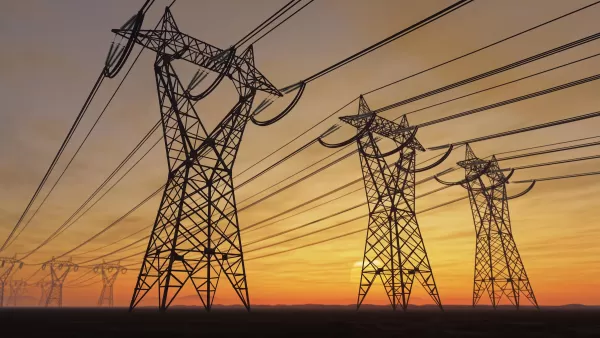Tweaks to US Data Centers Could Unlock 76 GW of New Power Capacity

The rapid expansion of AI has sent tech companies, data center developers, and power utilities into a frenzy over the potential for soaring electricity demand in the U.S. Yet, a recent study offers a glimmer of hope, suggesting that a small tweak in how data centers manage their electricity consumption could significantly ease the strain on the grid.
The study proposes that if data centers and other major electricity consumers were to limit their power draw to 90% of their maximum for just a couple of hours at a time—totaling about one day a year—they could free up an impressive 76 gigawatts of capacity across the U.S. To put this into perspective, that's more than the total electricity used by data centers worldwide, according to Goldman Sachs, and it represents about 10% of the peak demand in the U.S. The more data centers curtail their usage, the more capacity they could unlock.
This concept of demand response isn't new. For years, utilities have incentivized large electricity users such as shopping malls, universities, and factories to reduce their power usage during peak times, like sweltering summer afternoons. In exchange for turning down the AC or powering off energy-intensive machines for a few hours, these users receive a bill credit. Data centers, however, have traditionally prioritized maintaining uptime and performance for their clients, opting out of such programs. But the study highlights that data centers could be prime candidates for demand response due to their inherent flexibility.
Strategies for Data Centers to Reduce Power Usage
The study outlines several ways data centers can adjust their power consumption:
- Temporal Flexibility: By shifting computing tasks to periods of lower demand. For instance, AI model training, which doesn't need to happen in real-time, could be rescheduled to avoid peak hours.
- Spatial Flexibility: Companies can move computational tasks to data centers in regions with lower demand. Additionally, operators can consolidate server loads and temporarily shut down some servers.
- Alternative Power Sources: For tasks that can't be delayed or relocated, data centers can rely on backup power sources like batteries, which can provide several hours of power quickly and efficiently.
Some companies are already experimenting with these strategies. Google, for example, uses its carbon-aware computing platform to facilitate demand response, a tool initially developed to reduce carbon emissions. Enel X collaborates with data centers to use batteries in uninterruptible power supplies (UPS) to support grid stability. Meanwhile, PG&E offers expedited grid connections to data centers that agree to participate in demand response programs.
While these adjustments won't entirely eliminate the need for new power sources, they could transform a potentially dire situation—where half of new AI servers might be underpowered—into one that's much more manageable.
Related article
 xAI Legal Chief Resigns Following Turbulent Year at Musk's Startup
Robert Keele Steps Down as xAI's Legal Chief After Yearlong Tenure
xAI's former head of legal Robert Keele announced his departure this week following just over a year at Elon Musk's artificial intelligence startup. The executive cited family priorit
xAI Legal Chief Resigns Following Turbulent Year at Musk's Startup
Robert Keele Steps Down as xAI's Legal Chief After Yearlong Tenure
xAI's former head of legal Robert Keele announced his departure this week following just over a year at Elon Musk's artificial intelligence startup. The executive cited family priorit
 Nvidia's AI Hype Meets Reality as 70% Margins Draw Scrutiny Amid Inference Battles
AI Chip Wars Erupt at VB Transform 2025
The battle lines were drawn during a fiery panel discussion at VB Transform 2025, where rising challengers took direct aim at Nvidia's dominant market position. The central question exposed a glaring contradict
Nvidia's AI Hype Meets Reality as 70% Margins Draw Scrutiny Amid Inference Battles
AI Chip Wars Erupt at VB Transform 2025
The battle lines were drawn during a fiery panel discussion at VB Transform 2025, where rising challengers took direct aim at Nvidia's dominant market position. The central question exposed a glaring contradict
 AI Skin Disease Detection: Essential Guide for Early Diagnosis
The global healthcare landscape faces numerous challenges, with early disease detection emerging as a critical factor in improving patient outcomes. Artificial intelligence presents groundbreaking opportunities in dermatology, where timely and precis
Comments (38)
0/200
AI Skin Disease Detection: Essential Guide for Early Diagnosis
The global healthcare landscape faces numerous challenges, with early disease detection emerging as a critical factor in improving patient outcomes. Artificial intelligence presents groundbreaking opportunities in dermatology, where timely and precis
Comments (38)
0/200
![JonathanGreen]() JonathanGreen
JonathanGreen
 August 18, 2025 at 1:00:59 PM EDT
August 18, 2025 at 1:00:59 PM EDT
C'est fou comme une petite modif peut libérer autant d'énergie ! 76 GW, ça donne envie de rêver à des data centers plus verts, mais est-ce que ça suivra vraiment ? 🤔


 0
0
![RalphPerez]() RalphPerez
RalphPerez
 August 6, 2025 at 5:00:59 PM EDT
August 6, 2025 at 5:00:59 PM EDT
This article's take on tweaking data centers to unlock 76 GW is wild! 😮 It's like finding extra juice in a squeezed lemon. Makes me wonder how much AI's gonna reshape our power grids. Anyone else think this could spark a green energy race?


 0
0
![RichardWhite]() RichardWhite
RichardWhite
 July 29, 2025 at 8:25:16 AM EDT
July 29, 2025 at 8:25:16 AM EDT
The idea of unlocking 76 GW with just tweaks is wild! 😮 Makes me wonder how much more AI can push the grid before we hit a wall. Efficiency is key, but are we ready for the energy demands of super-smart AI?


 0
0
![HenryJackson]() HenryJackson
HenryJackson
 April 26, 2025 at 1:42:35 AM EDT
April 26, 2025 at 1:42:35 AM EDT
米国のデータセンターの調整は有望に聞こえますが、76 GWの電力を解放するというアイデアは驚くべきものです!AIによるエネルギー危機への潜在的な解決策を見るのは素晴らしいです。唯一の欠点は、これがまだ研究段階であり、実際の行動が必要だということです。早く実際の変化につながることを願っています!🔌


 0
0
![AndrewWilson]() AndrewWilson
AndrewWilson
 April 25, 2025 at 6:18:34 AM EDT
April 25, 2025 at 6:18:34 AM EDT
Ajustes nos centros de dados dos EUA parecem promissores, mas a ideia de liberar 76 GW de energia é de tirar o fôlego! É ótimo ver soluções potenciais para a crise energética causada pela IA. O único ponto negativo é que ainda é apenas um estudo, e precisamos de ações reais. Vamos torcer para que isso leve a mudanças concretas em breve! 🔌


 0
0
![HarperJones]() HarperJones
HarperJones
 April 23, 2025 at 11:11:00 AM EDT
April 23, 2025 at 11:11:00 AM EDT
미국 데이터 센터의 조정은 promising해 보이지만, 76 GW의 전력을 해제한다는 아이디어는 정말 놀랍네요! AI로 인한 에너지 위기의 잠재적 해결책을 보는 건 멋진 일이에요. 유일한 단점은 아직 연구 단계라는 점이고, 실제 행동이 필요해요. 곧 실제 변화로 이어지길 바랍니다! 🔌


 0
0

The rapid expansion of AI has sent tech companies, data center developers, and power utilities into a frenzy over the potential for soaring electricity demand in the U.S. Yet, a recent study offers a glimmer of hope, suggesting that a small tweak in how data centers manage their electricity consumption could significantly ease the strain on the grid.
The study proposes that if data centers and other major electricity consumers were to limit their power draw to 90% of their maximum for just a couple of hours at a time—totaling about one day a year—they could free up an impressive 76 gigawatts of capacity across the U.S. To put this into perspective, that's more than the total electricity used by data centers worldwide, according to Goldman Sachs, and it represents about 10% of the peak demand in the U.S. The more data centers curtail their usage, the more capacity they could unlock.
This concept of demand response isn't new. For years, utilities have incentivized large electricity users such as shopping malls, universities, and factories to reduce their power usage during peak times, like sweltering summer afternoons. In exchange for turning down the AC or powering off energy-intensive machines for a few hours, these users receive a bill credit. Data centers, however, have traditionally prioritized maintaining uptime and performance for their clients, opting out of such programs. But the study highlights that data centers could be prime candidates for demand response due to their inherent flexibility.
Strategies for Data Centers to Reduce Power Usage
The study outlines several ways data centers can adjust their power consumption:
- Temporal Flexibility: By shifting computing tasks to periods of lower demand. For instance, AI model training, which doesn't need to happen in real-time, could be rescheduled to avoid peak hours.
- Spatial Flexibility: Companies can move computational tasks to data centers in regions with lower demand. Additionally, operators can consolidate server loads and temporarily shut down some servers.
- Alternative Power Sources: For tasks that can't be delayed or relocated, data centers can rely on backup power sources like batteries, which can provide several hours of power quickly and efficiently.
Some companies are already experimenting with these strategies. Google, for example, uses its carbon-aware computing platform to facilitate demand response, a tool initially developed to reduce carbon emissions. Enel X collaborates with data centers to use batteries in uninterruptible power supplies (UPS) to support grid stability. Meanwhile, PG&E offers expedited grid connections to data centers that agree to participate in demand response programs.
While these adjustments won't entirely eliminate the need for new power sources, they could transform a potentially dire situation—where half of new AI servers might be underpowered—into one that's much more manageable.
 xAI Legal Chief Resigns Following Turbulent Year at Musk's Startup
Robert Keele Steps Down as xAI's Legal Chief After Yearlong Tenure
xAI's former head of legal Robert Keele announced his departure this week following just over a year at Elon Musk's artificial intelligence startup. The executive cited family priorit
xAI Legal Chief Resigns Following Turbulent Year at Musk's Startup
Robert Keele Steps Down as xAI's Legal Chief After Yearlong Tenure
xAI's former head of legal Robert Keele announced his departure this week following just over a year at Elon Musk's artificial intelligence startup. The executive cited family priorit
 Nvidia's AI Hype Meets Reality as 70% Margins Draw Scrutiny Amid Inference Battles
AI Chip Wars Erupt at VB Transform 2025
The battle lines were drawn during a fiery panel discussion at VB Transform 2025, where rising challengers took direct aim at Nvidia's dominant market position. The central question exposed a glaring contradict
Nvidia's AI Hype Meets Reality as 70% Margins Draw Scrutiny Amid Inference Battles
AI Chip Wars Erupt at VB Transform 2025
The battle lines were drawn during a fiery panel discussion at VB Transform 2025, where rising challengers took direct aim at Nvidia's dominant market position. The central question exposed a glaring contradict
 AI Skin Disease Detection: Essential Guide for Early Diagnosis
The global healthcare landscape faces numerous challenges, with early disease detection emerging as a critical factor in improving patient outcomes. Artificial intelligence presents groundbreaking opportunities in dermatology, where timely and precis
AI Skin Disease Detection: Essential Guide for Early Diagnosis
The global healthcare landscape faces numerous challenges, with early disease detection emerging as a critical factor in improving patient outcomes. Artificial intelligence presents groundbreaking opportunities in dermatology, where timely and precis
 August 18, 2025 at 1:00:59 PM EDT
August 18, 2025 at 1:00:59 PM EDT
C'est fou comme une petite modif peut libérer autant d'énergie ! 76 GW, ça donne envie de rêver à des data centers plus verts, mais est-ce que ça suivra vraiment ? 🤔


 0
0
 August 6, 2025 at 5:00:59 PM EDT
August 6, 2025 at 5:00:59 PM EDT
This article's take on tweaking data centers to unlock 76 GW is wild! 😮 It's like finding extra juice in a squeezed lemon. Makes me wonder how much AI's gonna reshape our power grids. Anyone else think this could spark a green energy race?


 0
0
 July 29, 2025 at 8:25:16 AM EDT
July 29, 2025 at 8:25:16 AM EDT
The idea of unlocking 76 GW with just tweaks is wild! 😮 Makes me wonder how much more AI can push the grid before we hit a wall. Efficiency is key, but are we ready for the energy demands of super-smart AI?


 0
0
 April 26, 2025 at 1:42:35 AM EDT
April 26, 2025 at 1:42:35 AM EDT
米国のデータセンターの調整は有望に聞こえますが、76 GWの電力を解放するというアイデアは驚くべきものです!AIによるエネルギー危機への潜在的な解決策を見るのは素晴らしいです。唯一の欠点は、これがまだ研究段階であり、実際の行動が必要だということです。早く実際の変化につながることを願っています!🔌


 0
0
 April 25, 2025 at 6:18:34 AM EDT
April 25, 2025 at 6:18:34 AM EDT
Ajustes nos centros de dados dos EUA parecem promissores, mas a ideia de liberar 76 GW de energia é de tirar o fôlego! É ótimo ver soluções potenciais para a crise energética causada pela IA. O único ponto negativo é que ainda é apenas um estudo, e precisamos de ações reais. Vamos torcer para que isso leve a mudanças concretas em breve! 🔌


 0
0
 April 23, 2025 at 11:11:00 AM EDT
April 23, 2025 at 11:11:00 AM EDT
미국 데이터 센터의 조정은 promising해 보이지만, 76 GW의 전력을 해제한다는 아이디어는 정말 놀랍네요! AI로 인한 에너지 위기의 잠재적 해결책을 보는 건 멋진 일이에요. 유일한 단점은 아직 연구 단계라는 점이고, 실제 행동이 필요해요. 곧 실제 변화로 이어지길 바랍니다! 🔌


 0
0





























